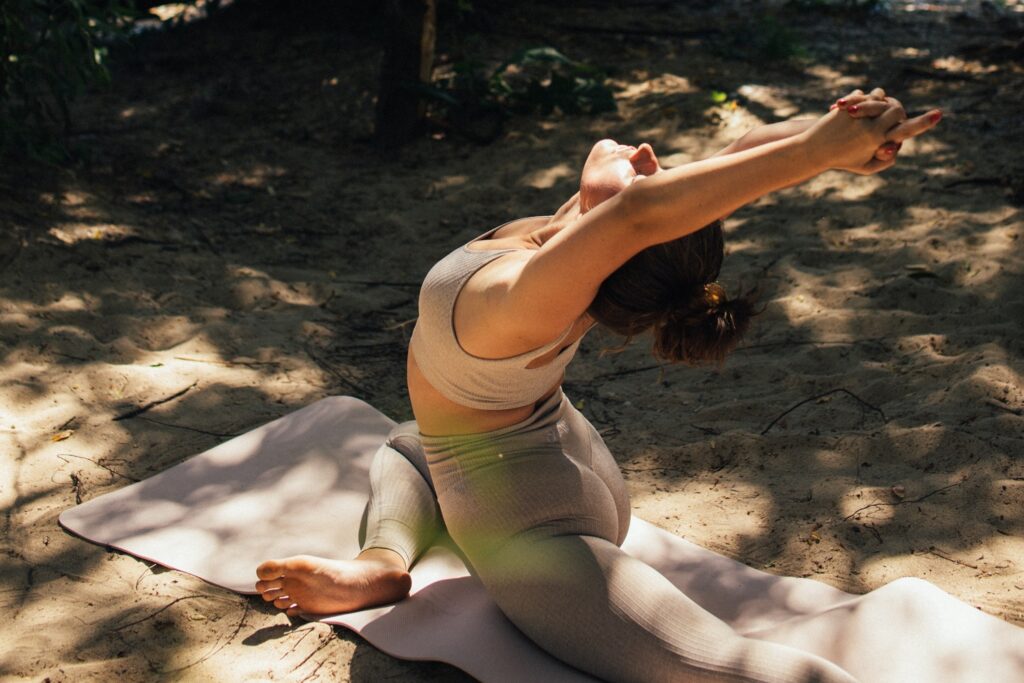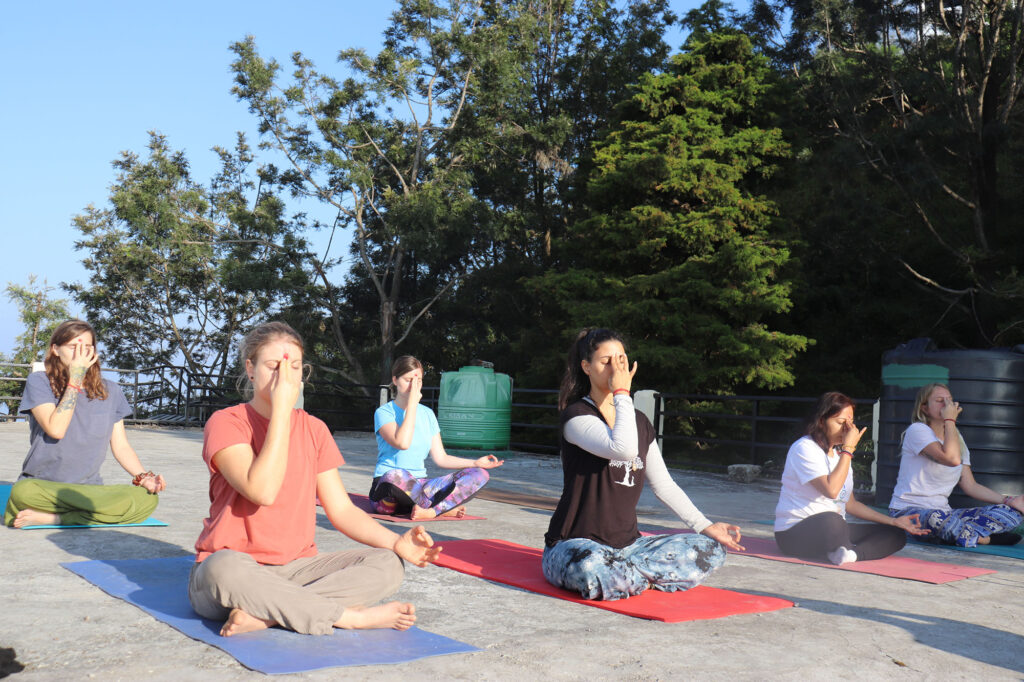Healthy lifestyle crisis today… Yes..
We are facing what can be called a pandemic of lifestyle disorders. Changes must be made consciously by individuals themselves to live a healthier life, and know how to manage emotions and stress.


Yoga is the best lifestyle ever conceived because it has potential in the prevention, management, and rehabilitation of common lifestyle disorders.
Yogic lifestyle, yogic diet, yogic attitudes and various yogic methods help men to strengthen themselves physically and mentally to develop positive health thus enabling them to resist stress better.
Yogic practice normalizes the perception of stress, optimizes it by releasing it through various yogic practices.
Several studies conducted in Pondicherry, India have demonstrated the positive effects of yoga on lifestyle disorders.
It is then quite interesting to understand that the future of health care in general could develop the use of yoga in integrative health care.
Besides, we can observe the development of alternative medicine like hypnosis in some hospitals today.
Yoga determines healthy lifestyle components (healthy diet, regular exercices, relaxation, positive attitude, healthy happy living) and psychosomatic harmonizing effects of pranayama and yogic relaxation.
Components of a healthy lifestyle


Yoga places great emphasis on a proper and healthy lifestyle and its major components which are also found in Ayurveda are:
- Achar (wholesome activities),
- Vichar (healthy relationships and healthy thoughts)
- Ahar (healthy food)
- And vihar (wholesome recreation).
The basic yogic principles help manage lifestyle disorders and psychologically reconditions to develop healthy life habits:
- Stress management with normalization of metabolism
- Relaxation, visualization and contemplative practices.
Yoga is an art and a science that is the best natural and effective way of life to manage common disorders such as diabetes and hypertension, mood disorders, schizophrenia, depression, migraines, hormonal disorders, weight loss…
And today, research looks at the beneficial psychophysiological effects of yoga and realizes that it goes beyond physical exercise since it impacts the general homeostasis of the body.
Lifestyle habits and Scientific Studies
Comprehensive reviews have suggested that yoga reduces cardiovascular risk profile by decreasing activation of the sympatho-adrenal system and hypothalamic-pituitary-adrenal axis and also by promoting a sense of well-being as well than a direct improvement in parasympathetic activity (Innes, Bourguignon & Taylor, 2005; Innes and Vincent, 2007).
All of the studies reviewed suggest that yoga significantly improves lipid profile, and since this is an important risk factor for heart disease, on the risk indices associated with the syndrome of insulin resistance, …
An unsuitable lifestyle has a negative impact on the functioning of the autonomic nervous system (ANS). Studies have shown that the central nervous system is affected in diabetes mellitus. A comprehensive 6-week therapeutic yoga program produces a significant shortening of reaction time in diabetic patients (Madanmohan, Thombre, Das, Subramanian, & Chandrasekar, 1984; Madanmohan, Bhavanani, Dayanidy, Sanjay, & Basavaraddi, 2012). It has also been reported that the yoga improves nerve conduction (Malhotra et al., 2002) and biochemical profile (Gordon et al., 2008) in patients with diabetes mellitus.
Yoga is also effective in reducing risk factors for cardiovascular disease and diabetes, in reducing body weight, blood pressure (BP), glucose levels and cholesterol (Yang, 2007).
The pranayama also has immediate effects on hypertension and yoga has proven to be an effective complementary therapy:
Healthy reductions in heart rate with the beneficial practice of sukha (inhale = exhale), savitri (6:3:6:3 rhythm for inhale: hold: exhale and hold breath while sitting and lying down), chandra nadi (breath exclusive left nostril) and pranava pranayama (using audible AUM chanting during prolonged sequential exhalation while sitting and lying down) have been reported.
Normalization of autonomic cardiovascular rhythms with increased endogenous nitric oxide production.
These are simple and economical techniques that can be added in addition to the usual medical care. Healthy lifestyle is the key.
Role of Yoga in Modulating the Stress Response


Stress plays a vital role in increasing, precipitating or aggravating all lifestyle disorders. We understand that we can improve our lifestyles through yoga.
Stress leads to:
1. An imbalance of the Autonomic Nervous System with a decrease in parasympathetic activity and an increase in sympathetic activity
2. An under-activity of the gamma-aminobutyric acid (GABA) system, the main system of inhibitory neurotransmitter
3. An increase in allostatic load (aconcept that refers to the negative consequences of stress on the body that accumulate over time).
Yoga-based practices correct under-activity of the parasympathetic nervous system and GABA systems in part through stimulation of the vagus nerves, the major peripheral pathway of the parasympathetic nervous system, and reduce allostatic load.
Thus the decrease in the parasympathetic nervous system and GABA activity involved in stress-related disorders can be corrected by yogic practices, leading to an improvement in the symptoms of the disease.
Yoga management for lifestyle disorders
The basic yogic principles used in the management of lifestyle disorders are as follows:
1. Psychological reconditioning and the development of appropriate attitudes :
Such as yama-niyama, chaturbhavana and pratipaksha bhavanam.
- Chatur Bhavana
- These attitudes which help us to control our mental processes are:
- Kindness to those who are happy (Maitri – Sukha);
- Compassion towards those who are unhappy (Karuna – Dukha);
- Good humor towards the virtuous (Mudhita – Punya);
- And indifference towards the wicked (Upekshanam – Apunya).
These principles help us to create a yogic attitude of Sama Bhava or equality of mind in all situations. They also help us overcome Kleshas (dark thoughts), and give us answers on how to live a yogic life. They make us human and help us to live in the social structure in a healthy and happy way.
Pratipaksha Bhavanam.
The concept of Pratipaksha Bhavanam is an amazing teaching and must be inculcated in our daily life Sadhana as we come across it so many times every day. While we can’t replace negative thoughts with emotionally charged positive reinforcements, we should at least try to stop them in their tracks! I have personally found that a strong “STOP” type statement works wonders to help block negative thoughts that would otherwise lead us down the cesspool of quicksand, into bigger and bigger problems. Tiruvalluvar advises us to return the negative actions of others with positive and selfless actions.
2. Stress management
Through counselling, jathis (release techniques), asanas (postures), kriyas (systematic rational movements of breath-body coordination) and pranayama (breath-energy harmonization techniques)
3. Normalizing metabolic activity
Helping to normalize metabolic activity through physical activity such as surya namaskar, asanas, kriyas and pranayama
4. Relaxation, visualization and contemplation
To induce feelings of inner calm and well-being.
One of the purposes of yoga is to encourage positive hygiene and health through the development of the natural powers of body and mind. It yoga pays particular attention to the processes of elimination and cleansing and redevelops the inner powers of adaptation and adjustment of body and mind. We can thus strive for positive health and enjoy it.
Yoga also entails nadi shuddhi (purification of all channels of communication) and mala shuddhi (eradication of factors that disturb the balanced functioning of body and mind).
Yoga helps cultivate positive and healthy lifestyle by:
Cultivating correct psychological attitudes:
- Masters benevolence, loving-kindness, kindness, friendliness, goodwill and active concern for others.
- Karuna – compassion,
- Mudita – joy; especially sympathetic or vicarious joy, or pleasure in rejoicing in what others are doing.
- Pekshanam – non-attachment, a balanced mind and tolerance towards those who are sukha (in joy), duhkha (in pain), punya (auspicious, virtuous), and apunya (wicked, bad)
- Reconditioning of the neuromuscular system and neuroglandular allowing the body to better resist stress and effort.
- Have an adequate diet conducive to optimal health
To lead a healthy life, our actions must be healthy.
Yoga and Ayurveda define 4 actions that we must observe:
- Achar: wholesome activities such as physical exercise with regular practice of asanas, pranayamas and kriyas. Cardiorespiratory health is one of the main side effects of these healthy activities.
- Vichar: The right thoughts and the right attitude towards life are vital for well-being. A balanced state of mind is achieved by following moral and ethical values (yama-niyama).
- Ahar: sattvic diet: fresh foods, green salads, sprouts, unrefined grains and fresh fruits prepared and served with love and affection
- Vihar: Appropriate recreational activities to relax body and mind are essential for good health. (appropriate relaxation, maintenance of stillness of actions-words-thoughts and group activities, in which one loses the sense of individuality). Karma Yoga is an excellent method to lose the sense of individuality and gain a sense of universality.
Cultivate healthy attitudes by developing yogic attitudes towards every aspect of life. This is inseparable for reducing stress which is most often an inner overreaction.
Achieve clarity of mind (chitta prasadhanam) through the attitudes advocated by Maharishi Patanjali (maitri, karuna, mudita and upekshanam).
It is important to adopt the viewpoint opposed to negative thoughts and actions (pratipaksha bhavanam) and to emphasize the principles of Karma Yoga, Raja Yoga and Bhakti Yoga in daily life.
A healthy and heart-friendly diet
It is important to have a healthy diet. And healthy lifestyle is also:
- Regular meals
- Adequate amounts of salad greens, sprouts, fenugreek, turmeric, bitter gourd and neem.
- The minimum possible amount of salt in the diet
- Maintain good hydration
- Eat when hungry and after digesting the previous meal,
- Regularly eat small meals with complex carbohydrates and avoid refined and junk foods.
- Coordination of breath and body movements
- Body-mind harmony is enhanced by practices using breath-related movements
Sukshma Vyayama practices (Sukshma Vyayama is the system of yogic practices which loosens your joints and removes the energy blockages. This system has a strong purifying effect thus, boosting the body energy. Yogic Sukshma Vyayamas (Loosening and strengthening. practices) are safe, rhythmic, repetitive stretching movements and Sheetalikarana Vyayama (physical. movements that mobilize and activate different parts of the body. by repetitive jerky, forceful movements) as well as pleasant jathis are helpful in this regard
Surya namaskar performed slowly and with breath awareness can also produce psychosomatic harmony and postures can be held effortlessly for a short time with meditative awareness of surya mantras (names of the sun)
Asanas for healthy lifestyle
The following postures or asanas may be used depending on the physical condition and other associated health problems of the patient.
Standing postures: tadasana, trikonasana, padottanasana, hasthapada asana, padangushta asana and mehru asana are helpful.
Lying postures: bhujangasana and ardha shalabasana
Useful seated postures include vakrasana, gomukhasana, ustrasana, shashasana and yoga mudra asana.
Lying postures: matsyasana, pavana mukta asana and eka and dwipada uttanpada asana.
Upside-down poses can help reset the mechanisms that regulate blood pressure. This can also be achieved by head under heart postures which do the same if the patient cannot do postures such as sarvangasana and sethubanda sarvangasana.
Pranayamas: pranava pranayama are very useful, as well as chandra bhedana and chandra nadi pranayamas which help to reduce sympathetic overactivity.


Savitri, nadi shuddhi and bhramari pranayama are excellent practices for reducing stress.
Sheetali and sitkari also produce a feeling of relaxation.
Kriyas to cleanse toxins
Cleansing practices such as kunjal, nauli, kapalabhati, agnisara, shanka prakshalana can be practiced according to individual predisposition. Some require a bit of learning to do them correctly.
The Viparita karani mudras help by virtue of being “the head under the heart” and also has a profound effect on the psychoneuro-endocrine axis.
Shanmuki mudra produces a feeling of inner calm
Brahma mudra, by working with breath and vibration (nada), induces a feeling of relaxation and invigoration in the head and neck region which reduces stress and normalizes reflex mechanisms.
Yogic Relaxation
Hatha Yoga relaxation practices can be practiced from savasana and include spandha nishpandha kriya (alternating tension and relaxation), marmanasthanam kriya (part-by-part relaxation), and kaya kriya (dynamic body relaxation).
Jnana Yoga such as anuloma viloma kriya and yoga nidra can help reduce stress levels and create psychosomatic harmony. Even the simple makarasana is an excellent antidote to stress and psychosomatic disorders.
Dharana and dhyana
Concentration practices that induce a meditative state include the popular om japa and ajapa japa.
Chakra dhyana
This practice focuses on the seven vital “chakras”, or energy centers, located along our spine. The activation of these chakras or energy centers triggers the expansion of consciousness and allows one to move from a lower state of existence to a higher state of existence in the planes of consciousness.
The dharana mandala can be done on all chakras with special emphasis on the anahata chakra to harmonize prana vayu which is based in the heart region and on the navel center to harmonize samana vayu to the manipura chakra.
Yoga advices
Yoga is essentially a preventive life science:
Heyam dukhkam anagatham – Yoga Darshan II: 16: Coming pain should be avoided).
The counseling process is not one-time, it is an ongoing process that starts from the very first visit and continues with each session at different levels.
Conclusion
Yoga offers great potential in the prevention and management of lifestyle disorders and diseases.
The healthy lifestyle with yoga science brings about improved health at different physical, mental and spiritual levels.
Yoga has the potential to prevent disease progression and if started early may even manifest a cure.
The majority of studies on yoga and health are positive, and would support the use of yoga as part of the integrative health care system in particular.
Yoga brings different components to the lifestyle: healthy eating, activity, relaxation and positive attitude, and harmonizing psychosomatic effects through pranayama and yogic relaxation.
It involves both the process and the attainment of a psychosomatic state of harmony and balance (samatvam yoga uchyate: Yoga is a state of balance – Bhagavad Gita) and this restoration of physical balance, mental, emotional and spiritual may be the overriding factor. behind the changes observed in all short-term and long-term studies.
Yoga is without side effects and multiple collateral benefits, safe, easy to learn and can be practiced even by sick, elderly or disabled people.
So, if you realize and take conscious that is NOW you have to act to learn healthy lifestyle habits by practicing yoga and ayurveda, book your 1st free yoga class with me here.
Namaste
Julie
